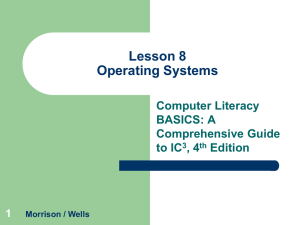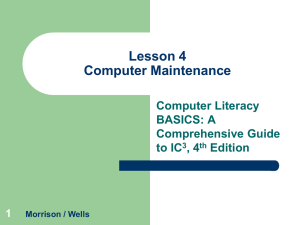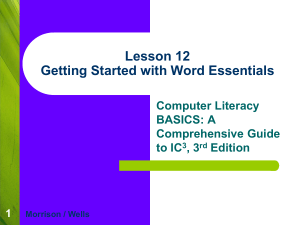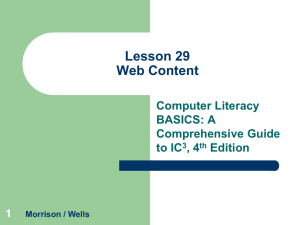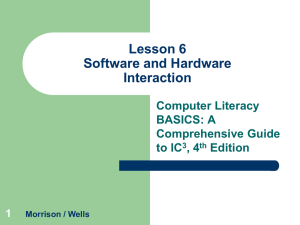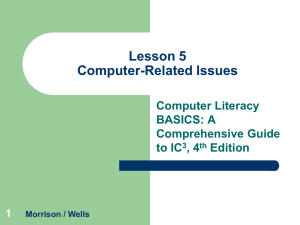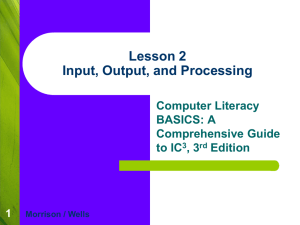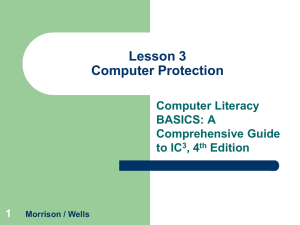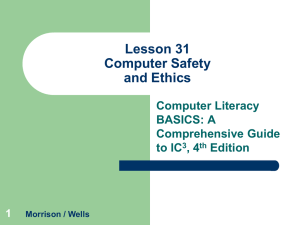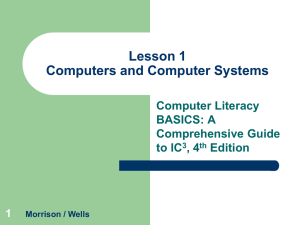Lesson 14 Sharing Documents
advertisement
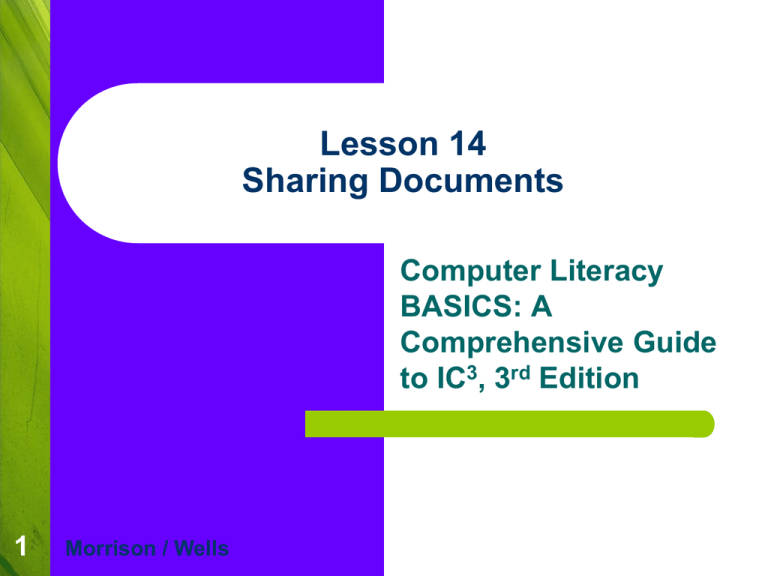
Lesson 14 Sharing Documents Computer Literacy BASICS: A Comprehensive Guide to IC3, 3rd Edition 1 Morrison / Wells Objectives Lesson 14 2 Track changes and add comments. Protect documents by restricting access and by restricting revisions and comments. Modify printer settings. Pause and cancel print jobs. Troubleshoot printing problems. Prepare documents for electronic distribution. Send documents via e-mail or fax. Morrison / Wells CLB: A Comp Guide to IC3 3E Vocabulary Lesson 14 3 comment document management server document workspace duplex printing encryption Morrison / Wells hard copy markup metadata Portable Document Format (PDF) read-only document print queue CLB: A Comp Guide to IC3 3E Vocabulary (continued) Lesson 14 soft copy XML Paper Specification (XPS) 4 Morrison / Wells CLB: A Comp Guide to IC3 3E Introduction Lesson 14 5 The development of a document may involve multiple team members. Collaboration features in Word can help individuals contribute effectively to the development of a document. Morrison / Wells CLB: A Comp Guide to IC3 3E Revising Documents Lesson 14 6 Tracking changes with revision marks makes it easy to identify edits from team members. Adding comments is another useful feature. Revision marks and annotations that appear in a document are referred to as markup. Morrison / Wells CLB: A Comp Guide to IC3 3E Revising Documents (continued) Lesson 14 7 Tracking Changes: When the Track Changes feature is toggled on, all insertions, deletions, and format changes are indicated with revision marks such as font color, underlines, and balloons in the margins. Morrison / Wells CLB: A Comp Guide to IC3 3E Revising Documents (continued) Lesson 14 Tracking Changes (cont): Revision marks identify who made the changes and when the changes were made. 8 Morrison / Wells CLB: A Comp Guide to IC3 3E Revising Documents (continued) Lesson 14 9 Adding Comments: Use the Insert Comment button to insert a comment, which is a note that the author or a reviewer adds to the document. Morrison / Wells CLB: A Comp Guide to IC3 3E Revising Documents (continued) Lesson 14 Adding Comments (cont): You can choose how the comments will appear in the document and whether or not the comments will be included when you print. 10 Morrison / Wells CLB: A Comp Guide to IC3 3E Revising Documents (continued) Lesson 14 11 Showing Markup: You can choose from several options to show the markup. For example, you can choose to show only the edits from a specific reviewer, or you can choose to view only the comments added to the document. Morrison / Wells CLB: A Comp Guide to IC3 3E Revising Documents (continued) Lesson 14 12 Accepting/Rejecting Changes: After changes and comments are added, the edited document is passed to a person who decides whether to accept or reject the changes and can also remove the comments. Morrison / Wells CLB: A Comp Guide to IC3 3E Protecting Documents Lesson 14 13 Word enables you to control sensitive information and collaborate in confidence. Restricting Access: Saving a document as read-only allows others to open it, but they can’t make changes to it. Encryption is a standard method for encoding data. A password is assigned, and then all users must enter the password to open the document. Morrison / Wells CLB: A Comp Guide to IC3 3E Protecting Documents (continued) Lesson 14 14 Restricting Formatting and Edits: The Protect Document button on the Review tab opens a task pane you can use to be selective about who is allowed to make edits as well as the types of edits they can make. Morrison / Wells CLB: A Comp Guide to IC3 3E Preparing a Document for Printing Lesson 14 15 A hard copy is a printed copy of a document. Your system may have two or more printers available with various options. Selecting Print Options: Most printers have settings for adjusting the printing speed and print quality. Some printers provide special features like duplex printing, which is printing on both sides of the page. Another option is to collate, which arranges the pages in proper order. Morrison / Wells CLB: A Comp Guide to IC3 3E Preparing a Document for Printing (continued) Lesson 14 Showing the Print Queue: The print queue shows information about documents that are waiting to print. 16 Morrison / Wells CLB: A Comp Guide to IC3 3E Preparing a Document for Printing (continued) Lesson 14 17 Troubleshooting Common Printing Problems: There are times when the print results do not meet expectations. Morrison / Wells CLB: A Comp Guide to IC3 3E Sharing Electronic Files Lesson 14 18 Instead of producing a hard copy of a document, it is now common practice to share a soft copy, or digital copy of data. Preparing Documents for Electronic Distribution: You may want to control metadata, or data that describes other data. If others are working with an older version of Word, you may choose to save the document in a previous Word format. Morrison / Wells CLB: A Comp Guide to IC3 3E Sharing Electronic Files (continued) Lesson 14 19 Preparing Documents for Electronic Distribution (cont): You can update information about the author, title, subject matter, and keywords in the Document Information Panel. Morrison / Wells CLB: A Comp Guide to IC3 3E Lesson 14 Sharing Electronic Files (continued) 20 Preparing Documents for Electronic Distribution (cont): The Document Inspector allows you to remove personal information. Morrison / Wells CLB: A Comp Guide to IC3 3E Lesson 14 Sharing Electronic Files (continued) 21 Saving the Document in a PDF or XPS Format: The Portable Document Format (PDF) was created by Adobe Systems in 1993. Microsoft included the XML Paper Specification (XPS) format in the Office 2007 applications. Both formats are designed to preserve the visual appearance and layout of each page, and they enable fast viewing and printing. Morrison / Wells CLB: A Comp Guide to IC3 3E Lesson 14 Sharing Electronic Files (continued) 22 Sending and Publishing Documents: When distributing electronic copies of a document, you can choose to send the content in an e-mail message or in a fax message, or you can send the file as an attachment to an e-mail message. Another way to distribute a document is to publish the document to a document management server, which is a central location for storing, managing and tracking files. Morrison / Wells CLB: A Comp Guide to IC3 3E Sharing Electronic Files (continued) Lesson 14 23 Sending and Publishing Documents (cont): A document workspace is a Windows SharePoint Services Web site that provides tools for sharing and updating files and keeping colleagues informed about document status. Morrison / Wells CLB: A Comp Guide to IC3 3E Lesson 14 Summary 24 In this lesson, you learned: Tracking changes with revision marks makes it easy to identify who made the changes and when the changes were made. Reviewers can provide feedback without changing the content by adding comments to the document. You can choose the markup that you want to appear on the screen and when the document is printed. Morrison / Wells CLB: A Comp Guide to IC3 3E Summary (continued) Lesson 14 25 Revisions can be accepted or rejected, and comments can easily be removed from the document. You can protect documents by restricting access and by restricting revisions and comments. You can change your default printer and printer settings using the Print command. You can view, pause, and cancel print jobs waiting in the print queue. Morrison / Wells CLB: A Comp Guide to IC3 3E Summary (continued) Lesson 14 26 When sharing documents with others, you need to choose the appropriate document format. Before distributing a soft copy of a document, you may want to remove metadata. Morrison / Wells CLB: A Comp Guide to IC3 3E
